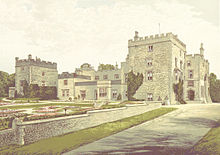Muncaster Castle

Muncaster Castle is a privately owned castle overlooking the Esk river, about a mile east of the west-coastal town of Ravenglass in Cumbria, England. It is recorded in the National Heritage List for England as a designated Grade I listed building.[1]
History

The place is now corruptly known as "Muncaster", which first appeared in a Cumberland church register in 1577, the original name according to all old evidence and records being "Mulcaster", registered in the pipe rolls of Cumberland circa 1150 (also as Molecaster and Mulecaster in 1190 and 1236 respectively).
The placename "Muncaster" contains the Latin word castra, meaning "encampment", or "fort".[2] It is suspected that the site of the castle lies on foundations dating to the Roman era, which, if they exist, may represent a castellum for the nearby Roman fort of Glannoventa at Ravenglass.[3]
Muncaster Castle is owned by the Pennington family, who have lived at Muncaster for at least 800 years. The Muncaster estate was granted to Alan de Penitone in 1208. The oldest parts of the castle include the Great Hall and the 14th century pele tower, a type of watch-tower fortification unique to the English-Scottish border region.
Between 1860 and 1866 Anthony Salvin extensively remodelled Muncaster Castle for the Barons Muncaster.[4] Sir John Frecheville Ramsden, 6th Baronet discussed proposed modifications to the castle with Edwin Lutyens from 1916, but nothing came of these; Lutyens did design the Muncaster War Memorial, constructed in 1922, on a commission from Ramsden.[5]
Muncaster's gardens include features designed to take advantage of views of the Esk Valley and the mountains.[6] There is an owl sanctuary, and a maze.
The Luck of Muncaster
After the Battle of Towton in 1461, according to tradition, Henry VI fled to Muncaster Castle where Sir John Pennington sheltered him. Henry gave Sir John a glass drinking bowl, in the hope that they should prosper so long as it remained unbroken. The glass, which is still intact, and still at the castle, is now known as 'The Luck of Muncaster'.[7]
See also
- Grade I listed buildings in Cumbria
- Listed buildings in Muncaster
- List of work on castles and country houses by Anthony Salvin
- Luck of Edenhall
- Castles in England
- List of historic houses in England
References
Citations
- ^ Historic England, "Muncaster Castle (1068780)", National Heritage List for England, retrieved 1 October 2012
{{cite web}}: CS1 maint: postscript (link) - ^ "Latin Word Lookup". Catholic.archives.nd.edu. Retrieved 2012-04-04.
- ^ Muncaster Castle and Ravenglass Bath House article at www.cambridgemilitaryhistory.com
- ^ Emery 1996, p. 232.
- ^ Historic England. "Muncaster War Memorial and area wall (1086636)". National Heritage List for England. Retrieved 7 September 2016.
- ^ Historic England, "Muncaster Castle Gardens (1000669)", National Heritage List for England, retrieved 1 October 2012
{{cite web}}: CS1 maint: postscript (link) - ^ "Muncaster - Monument to Henry VI". Archived from the original on 9 November 2012. Retrieved 27 February 2012.
Sources
- Emery, Anthony (1996), Greater Medieval Houses of England and Wales, 1300–1500, Volume I: Northern England, Cambridge: Cambridge University Press, ISBN 9780521497237
External links
- Cumbria County History Trust: Muncaster (nb: provisional research only - see Talk page)
- Muncaster Castle Website – Lake District Historical Houses
- Gatehouse Gazetteer record for Muncaster Castle, containing a comprehensive bibliography
- Muncaster Castle and Ravenglass Bath House article at www.cambridgemilitaryhistory.com
